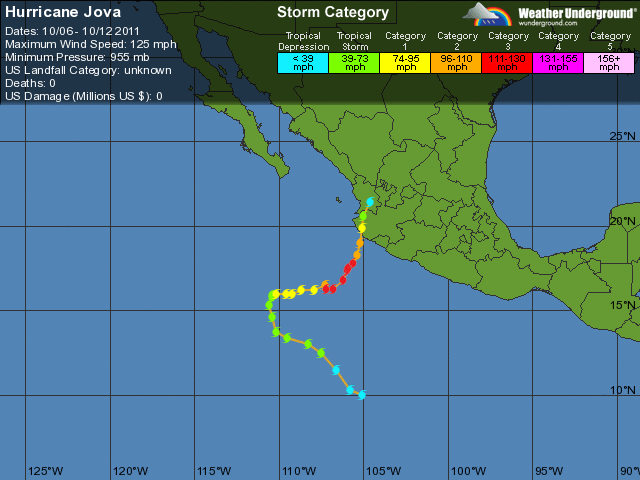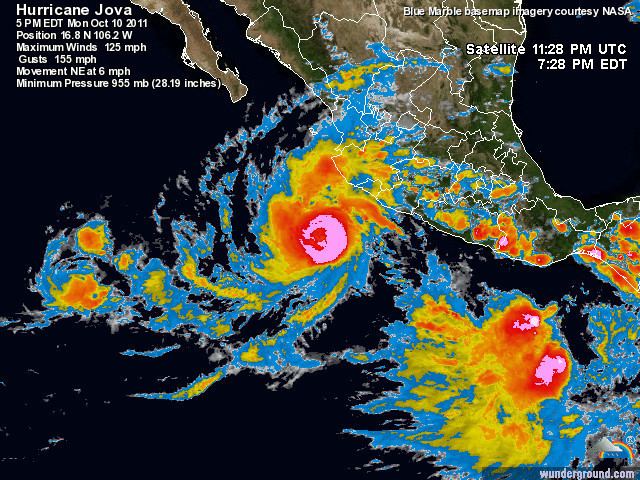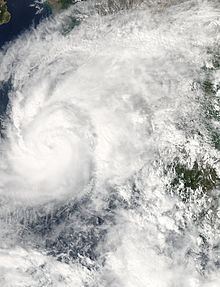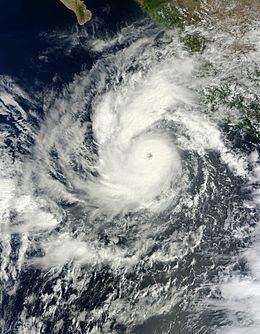Formed October 6, 2011 Fatalities 9 total | Dissipated October 12, 2011 Highest winds 201 km/h | |
 | ||
Lowest pressure 955 mbar (hPa); 28.2 inHg Damage $203.67 million (2011 USD) Date 6 October 2011 – 12 October 2011 Affected areas Western Mexico, Southwestern Mexico Similar Hurricane Hilary (2011), Hurricane Beatriz, Tropical Depression Twelve‑E, Hurricane Dora, Hurricane Kenneth | ||
Hurricane Jova was a strong Pacific hurricane that made landfall over Jalisco, Mexico. The tenth tropical depression and named storm, ninth hurricane, and fifth major hurricane of the 2011 Pacific hurricane season, Jova developed from an area of showers and thunderstorms that became better organized in early October. Moving towards the west-northwest, the area became better organized, and late on October 5, the National Hurricane Center began issuing advisories on Tropical Depression Ten-E. Steadily organizing, the storm was upgraded to Tropical Storm Jova later the following day, and by October 8, the storm had been classified as a Category 1 hurricane on the Saffir-Simpson hurricane scale. The storm attained Category 2 hurricane status late on October 9, and after a round of rapid intensification early on October 10, Jova had become a major hurricane.
Contents

Meteorological history

During the evening hours of October 3, an area of showers and thunderstorms had moved off the Colombian coastline. Moving slowly towards the west, the area of disturbed weather began gaining more convection, and late the following day, the National Hurricane Center (NHC) began monitoring the disturbance/. Over the course of the next day, the area of low pressure became better defined, and the convection associated with the low became more consolidated. Thus, the National Hurricane Center upgraded their chances of the low becoming a tropical cyclone to 50%. Under favorable conditions, the area of disturbed weather continued to quickly become organized, and late on October 5, the NHC began issuing advisories on Tropical Depression Ten-E, located 625 mi (1005 km) south of Manzanillo, Mexico. Embedded within a favorable environment for further strengthening, the depression slowly organized, and was upgraded to a tropical storm at 2100 UTC on October 6, while moving towards the northwest in response to a weakening Subtropical Ridge.

Moderate wind shear affected Jova throughout the day on October 7, when the low-level circulation was mainly located just to the north of the area of deep convection. However, the wind shear decreased early on October 8, and subsequently, Jova was upgraded to a Category 1 hurricane on the Saffir-Simpson hurricane scale during the afternoon hours of October 8 as it drifted towards the east-northeast. Late on October 9, the storm was upgraded to a Category 2 hurricane with a distinct eye feature evident. Early the following morning, Jova began a round of rapid intensification and became a major hurricane, with maximum sustained winds of 120 miles per hour (190 km/h). Moving towards the east, Jova reached its peak as a strong Category 3 with sustained winds of 125 mph (201 km/h) and a pressure of 955 mbar (28.2 inHg), just below Category 4 intensity. Jova made landfall as a Category 2 hurricane with sustained winds of 100 mph (160 km/h) and a pressure of 975 mbar (28.8 inHg) on La Huerta, Jalisco on October 12, and rapidly weakened over Mexico. Shortly after landfall, Jova rapidly dissipated to a remnant low, early on October 13.
Preparations

Early in Jova's duration, the National Hurricane Center predicted that it would strike southwestern Mexico as a hurricane in its five-day forecast. Beginning on October 8, the NHC advised residents in Mexico to monitor Jova's path. The next day, the Mexican government issued a hurricane watch from Punta San Telmo in southwestern Michoacán to Cabo Corrientes in Jalisco, with a tropical storm watch extending further south to Lázaro Cárdenas, Michoacán. Six hours later, watches were upgraded to their respective intensity warnings. A day later, a tropical storm watch was issued north of the hurricane warning area to San Blas, Nayarit.

In Puerto Vallarta, the port was closed. Residents boarded up shops and stayed at home and fisherman stocked up on food and water, though some people failed to prepare like they did in Hurricane Kenna, the last major hurricane to have severe effects on the region. Hotels were deserted and shops were closed. Even though no mandatory evacuations were ordered for the city, businesses were closed and boarded up in nearby towns. Officials in Jalisco opened up 70 shelters in 11 municipalities. The Manzanillo port was closed; 13 cargo ships were stuck after the port closed.
Impact
Nine people were killed by the storm, and six people were injured. A 71-year-old woman drowned in Colima after a strong current swept away the car in which she and her son were riding. In the neighboring state of Jalisco, Hurricane Jova triggered a mudslide in the town of Cihuatlan, just inland from the coast, that swept away a home, eventually killing a 21-year-old woman and her daughter. Flooding wiped way one bridge and destroyed stretches of highways leading out of Manzanillo. Several roads were damaged by the storm and landslides and flooding blocked three main highways connecting cities in Jalisco and Colima states. Power outages that resulted due to Jova affected 107,000 electricity customers.
Throughout Jalisco, losses from Jova reached 1.3 billion pesos ($96.1 million US$) and roughly 46,280 people were affected. In Colima, preliminary losses to the tourism industry were estimated at 170 million pesos ($12.7 million USD). Infrastructural damage from the storm in Colima reached 1.283 billion pesos ($94.87 million USD).
